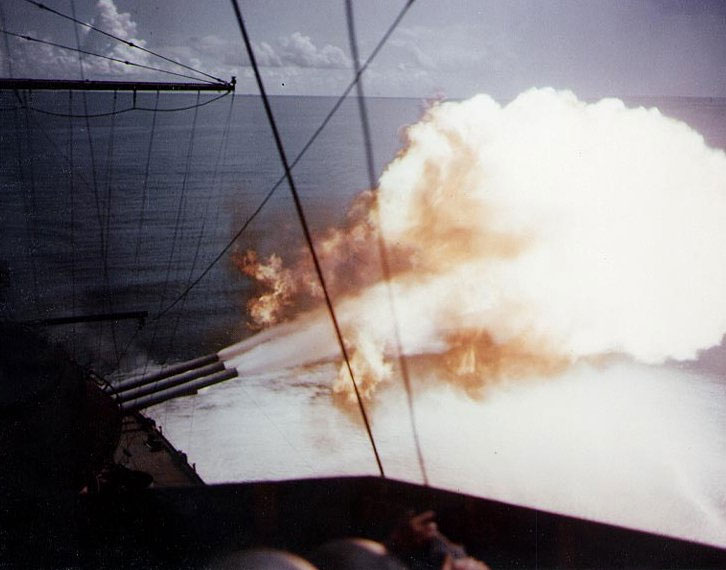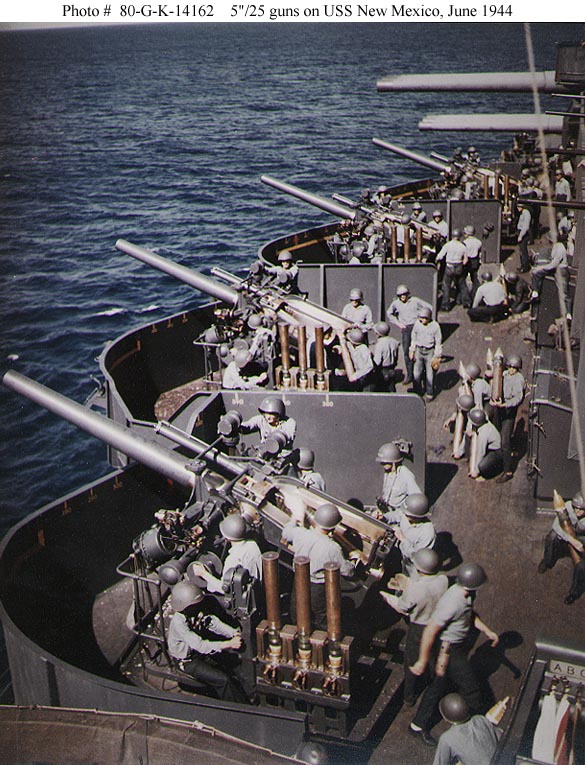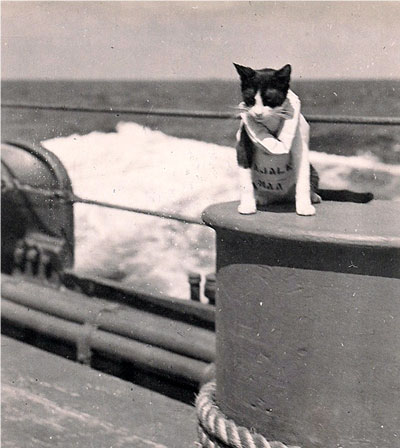| Battle for Saipan, Part Two
By David H. Lippman
February 2014
You can read Part One here.
Operation Forager got down to business on June 11, when Spruance’s vast fleet steamed to within 200 miles of the Marianas and the carriers began turning into the wind to launch 200 F6F Hellcat fighters, to hammer the 14 Japanese airfields on the islands. The Americans pounded the fields, and also spotted a convoy of 12 merchant ships, escorted by a torpedo boat, nine patrol craft and sub-chasers. They jumped on the convoy, sending the torpedo boat, three sub-chasers, and 10 merchant ships to the bottom. The planes did not go unscathed. Lt. Cdr. Robert H. Isely, commanding a squadron of rocket-armed TBM Avengers from Lexington, was hit by flak while on his dive. So was the plane next to him, and a third was damaged. Isely was a veteran pilot who had performed brilliantly in the Atlantic the previous year. The Americans later named a captured airfield on Saipan after him.
 The Americans spent two days pounding airfields and merchant ships parked in the Mariana Islands, before turning the bombardment task over to Vice Adm. Willis A. “Ching Chong” Lee’s seven fast battleships, Washington among them. Indiana began the shelling at 10:49 a.m., and Washington joined the party at 11:01 a.m. Japanese coast defense guns returned the American fire, to little effect. On Washington, observers enjoyed the sight of ammunition and fuel dumps exploding in fireballs. Lookouts noticed survivors of the Japanese convoy that had been sunk two days before still floating in the water . . . the destroyer Miller scooped up 17 of them. The Americans spent two days pounding airfields and merchant ships parked in the Mariana Islands, before turning the bombardment task over to Vice Adm. Willis A. “Ching Chong” Lee’s seven fast battleships, Washington among them. Indiana began the shelling at 10:49 a.m., and Washington joined the party at 11:01 a.m. Japanese coast defense guns returned the American fire, to little effect. On Washington, observers enjoyed the sight of ammunition and fuel dumps exploding in fireballs. Lookouts noticed survivors of the Japanese convoy that had been sunk two days before still floating in the water . . . the destroyer Miller scooped up 17 of them.
At 5:04 p.m., having fired 360 rounds of high-capacity 16-inch and 2,164 5-inch shells, Washington ceased fire. Storekeeper Gerard Thibodeau kept his own tally of the cost. “We in the Supply Office figured that every time a 16-inch shell was fired it was just about the price of a good new car,” he said later.
The fast battleships turned away, and Washington’s skipper, Capt. Glenn Davis, reported that he “considered the bombardment highly effective since the minesweeping group was able to conduct operations as planned with no enemy opposition. But partial damage to enemy guns and ammunition dumps is indicated from meager information available.”
The results were poor: designed and trained to cover carriers and fight opposing dreadnoughts, the gunners had churned up most of Saipan’s farmland and the Charan Kanoa sugar mill with their 15,000 shells, but done little damage to the Japanese defenses. Their spotter plane pilots had not learned to distinguish ground targets. The fast battleships had to fire their shells from 10,000 to 16,000 yards to avoid mined waters. An American sailor described the bombardment as “a Navy-sponsored farm project that simultaneously plows the fields, prunes the trees, harvests the crops, and adds iron to the soil.”
But the American shells did have an impact on Japanese morale: Sgt. Takeo Yamauchi was having breakfast when Lee’s ships steamed up. “I was eating a large rice ball when I heard a voice call out, ‘The American fleet is here!’ I looked up and saw the sea completely black with them. What looked like a large city had suddenly appeared offshore. Then the naval bombardment began. The first salvo exploded on the beach and objects suddenly went 60 meters straight up! The area was pitted like the craters of the moon. We clung to the earth in our shallow trenches and were half buried. Soil filled my mouth and blinded me. The fumes and flying dirt almost choked you. The next moment I might get it.”

Battleship New Mexico's 14-inch main battery opens fire.
Lee’s modern battleships turned the bombardment duty over to Rear Adm. Jesse Oldendorf’s task force of eight older battleships on June 14. While not as fast or sleek as Lee’s dreadnoughts, Oldendorf’s ships were heavily-trained for shore bombardment work, having practiced the task at Kahoolawe in Hawaii. They undertook their mission quite effectively, hurling 14-inch and 16-inch shells at Saito’s communications system and Nagumo’s shore batteries. The former was shredded, but most of the latter were heavily concealed, and went unscathed.
Up on a 30-foot-high observation tower on the slopes behind Garapan, Adm. Nagumo himself, peering myopically through a telescope at the American fleet, ruefully noted that four of them were the very ships he had pounded at Pearl Harbor in 1941: Maryland, Pennsylvania, California, and Tennessee. The overwhelming number of ships stunned Nagumo and his yeoman, Mitsuharu Noda, who had served Adm. Isoroku Yamamoto until Yamamoto’s death the year before. The dour old admiral, who had studied in America, described the ships to Noda, in a tone that indicated admiration as much as concern.
At 5:39 a.m., Oldendorf’s battleships and cruisers opened fire on a coastal battery of 6-inch guns on the cliffs of Nafutan Point. The Japanese returned fire, and a bluejacket on the cruiser Honolulu snarled, “The nerve of ‘em!”
With every shot timed, deliberate firing, and allowances strictly adhered to, the Americans raked the Japanese defenses. American historian Samuel Eliot Morison wrote, “There are few things prettier than a naval bombardment, provided one is on the sending not the receiving end and (as in this case) has lost all feeling of compassion for the human victims. Nearby ships belch great clouds of saffron smoke with a mighty roar. Distant ones are inaudible, but their flashes of gunfire leap out like the angry flick of a snake’s tongue. Planes drop white phosphorous bombs which explode in clouds white as new-fallen snow, and throw out silver streamers which ignite canefields, whence clouds of yellowish sugar-cane smoke arise.”
 On the light cruiser Montpelier, bluejacket James J. Fahey also described the bombardment in more prosaic terms, writing in his diary: “Thick smoke miles high was all over the island. I never saw anything like it before, it was like the great Chicago fire. Any large city would be in ruins if it took the shells and bombs Saipan took for a week. One time 25 Japs ran into a building and we got direct hits on it blowing it sky-high. You could see freight cars and tracks blow up. A big ammunition dump was blown to bits.” On the light cruiser Montpelier, bluejacket James J. Fahey also described the bombardment in more prosaic terms, writing in his diary: “Thick smoke miles high was all over the island. I never saw anything like it before, it was like the great Chicago fire. Any large city would be in ruins if it took the shells and bombs Saipan took for a week. One time 25 Japs ran into a building and we got direct hits on it blowing it sky-high. You could see freight cars and tracks blow up. A big ammunition dump was blown to bits.”
Nagumo’s batteries on Saipan tried to return fire, and inflicted hits on California, Tennessee, and the destroyer Braine, causing 62 casualties, including 12 dead. Saito reported to Tokyo that the bombing of June 11 was a routine “hit and run” affair, but Imperial Headquarters in Tokyo took a different view; they ordered the Combined Fleet to head for battle. By June 14, Saito had changed his tune, figuring that from the weight of the American bombardment, Charan Kanoa would be the invasion target. He shifted artillery back of the shore, withdrew his troops from enemy range, and set up his headquarters in a camouflaged cave on Hill 500, which gave him a box-seat view of the entire southern third of the island.
The shelling was hard. An unknown Japanese soldier wrote in a diary collected after the battle, which read: “I have at last come to the place where I will die. I am pleased to think that I will die calmly in true samurai style. Naval gunfire supported this attack, which was too terrible for words. I feel now like a full-fledged warrior.”
In Garapan, a Japanese volunteer nurse named Shizuko Miura, a tomboy with a round merry face, flinched as the shells slammed home. “I have lived for 18 years and my time to die has come,” Miura thought. A shell shook the dugout like an earthquake and knocked her to the ground. She staggered out of her building to see her first-aid station obliterated. A piece of red shrapnel lay near her. She touched it with her finger and suffered a burn. The town was burning, and the heat so intense that she could hardly breathe.
While Oldendorf’s dreadnoughts hurled their shells, Navy Underwater Demolition Teams (UDTs) moved in. Two 96-man teams moved off from destroyer-transports in landing craft, to blast gaps in reefs so that the amphibious craft and vehicles could swim ashore. They also planted marker buoys to guide the landing craft. At a cost of four men killed and five badly wounded by enemy rifles and machine guns, the UDT swimmers did their jobs. “Their skill, determination, and courage,” wrote Adm. Richmond Kelly Turner, “are deserving of the highest pride.”
That night, the American transports approached the island. The American target was the four-mile long beachfront that stretched from a mile south of Garapan through Charan Kanoa and down to Agingan Point, just above the southwestern tip of the island. The beaches were Red, Green, and Blue, from north to south. The northern beach was the responsibility of the 6th and 8th Regiments of the 2nd Marine Division, while the 23rd and 25th Regiments of the 4th Marine Division would take the southern sector. Each battalion was responsible for about 600 yards of front. Overall, 8,000 Marines would hit the beach in the first hour of battle alone.
A medical officer on one ship warned his men that they would face sharks, barracuda, sea snakes, razor-sharp coral, poison fish and giant clams in the surf. Then ashore would be the menace of leprosy, typhus, filariasis, typhoid, dysentery, and snakes, as well as the Japanese. A Marine private said, “Sir, why don’t we let the Japs keep the island?”
Other invaders listened to “Tokyo Rose,” who said, “I’ve got some swell recordings for you, just in from the States. You’d better enjoy them while you can, because tomorrow and 0600 you’re hitting Saipan . . . and we’re ready for you. So, while you’re still alive, let’s listen to . . .” She added that all the Marines would end up in a watery grave.
The story continues in Part Three.
Invade Saipan in Panzer Grenadier: Saipan 1944 - click here to order!

New Mexico's mascot jumped ship in Australia. A dog would
never have deserted.
A shorter version of this appeared in the February 2014 issue of WW2 History magazine, published by Sovereign Media, and is used with permission.
David H. Lippman, an award-winning journalist
and graduate of the New School for Social Research,
has written many magazine articles about World
War II. He currently works
as a public information officer for the city
of Newark, N.J. We're always pleased to add his work
to our Daily Content.
|
